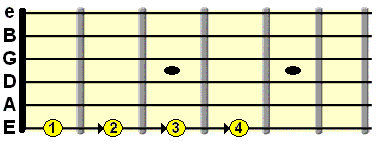Finger Warm Up Exercises for Guitar
Once you've been over the 5 minute finger stretching exercises, we can warm up using the guitar fretboard. This lesson will give you some effective finger warm-up exercises to further loosen those fingers up and get your picking co-ordination calibrated, ready for playing.You can also use the below exercises for general strength building, beyond the 10 minute warm up period. However, these exercises don't exactly offer much in the way of melodic ideas!
Note: all these exercises ideally require the use of alternate picking. Let's get started!Chromatic finger warm up exercises
This is a classic way to warm up - many guitarists swear by it.
 Chromatics
basically involve playing a sequence of semitone (one fret) intervals
one after the other.
Chromatics
basically involve playing a sequence of semitone (one fret) intervals
one after the other.
With the chromatic exercises below, use strict alternate picking to help get your hand-pick co-ordination up to scratch. Make sure each note/fret is cleanly separated from the last/next.
Start slow, using a metronome, and speed up gradually, making sure you are playing each note cleanly. You should only increase the tempo of the metronome once you are 100% confident with the current tempo.
The first chromatic exercise involves a vertical pattern across the 6 guitar strings. Look at the animation below, and follow the sequence all up the guitar neck...

It can get tricky as you get passed the 12th fret, because the fret spacings are smaller and those of us with long fingers can get a bit tangled up! Remember, don't touch that metronome's tempo until you can do this exercise cleanly - have discipline and patience!
You can also try the "stepped" chromatic sequence - same sequence as above, but this time you step up each fret for each string...

Step that pattern over all 6 strings, then just descend back down again in the same, or a different pattern (mix it up a little)

Now try reversing the arrows in the diagrams above.
Another variation (seems like we could go on forever here!) is to use the sequences above, but climb/ascend on one string and then fall/descend on the next string up.
You can probably guess what
I'm gonna tell you
now... try and come up with your own sequences (there's countless
combinations you can try). If you feel your fingers aching
that's actually a good sign you're giving them a workout. Shake off the
stiffness, wait a few seconds, and go again. Start slow and only when
you're physically comfortable with the pattern, then
you turn that metronome up a notch.
3 finger warm up patterns
As well as chromatics, you can try other patterns using just 3 of your fingers (in various combinations) to give that particular muscle memory some attention.
For example, in exactly the same movements as above in the chromatic exercises (e.g. first use the vertical movement, then the stepped etc.), try the patterns below using 3 fingers per string instead of 4...

So we skip one fret in that finger sequence above - this actually makes use of your finger muscles and joints in a different way to chromatics, because you're moving from the index finger to the ring finger, rather than index to middle finger.
Also, there's skipping from middle finger to pinky finger...

You can really have a good stretch by spanning the below three-finger pattern across 6 frets, still using the vertical and staggered sequences from earlier...

I use my index, middle and pinky for these
patterns!
Other useful finger exercises
Remember, these all still apply to those vertical and stepped sequences from the chromatic exercises on this page, but also try to mix them up a little (e.g. ascend up using the stepped sequence, then descend using the vertical sequence... or vice versa).
Using your index and ring fingers only...

Using your index and pinky fingers only...

Using your middle and pinky fingers only...

A pattern using all 4 fingers across 6 frets...

More...
Remember, these are only basic warm-up exercises - they do not cover techniques like string skipping and runs, which require yet another form of muscle memory. You'll learn these naturally as you progress with your lead playing (see the guitar scale exercises series for some ideas). Guitarists at first don't realise just how many different movements their fingers are required to make when playing guitar!
| |
Tweet |
Sign up to the newsletter for updates and grab your free Uncommon Chords book
Related Answers
Hand Strengthening Exercises
Related
Guitar Scale Exercises
Finger Stretching Exercises
Lead Guitar Lessons








